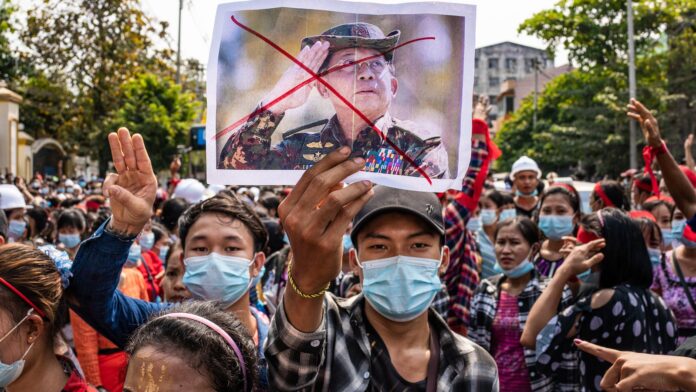In the complex political and security crisis following last Februaqry’scoup, Cambodian Prime Minister Hun Sen came in Myanmar on a two-day visit. Despite the fact that the junta-backed State Administration Council (SAC) is represented at Myanmar embassies in approximately 40 countries, this is the first visit by a head of state to Myanmar since the military seized power. Another reason for the enhanced focus in his visit was that Cambodia is chairing ASEAN this year. Myanmar was barred from attending the 36th ASEAN Summit after the junta failed to implement the five-point accord issued by ASEAN last year. Now, sidelining the ASEAN’s unanimity, Hun Sen’s bilateral meeting with Min Aung Hlaing naturally raises the question of whether Hun Sen is the Myanmar people’s saviour or the Myanmar dictatorship’s. It is believed that his visit is part of a backdoor diplomacy to relieve mounting pressure on the junta.
With an increasingly tumultuous domestic scenario, Tatmadaw is establishing fresh example of horror and ruthlessness in the ongoing armed conflict. By doing so, the junta administration is sending a clear message that any protest would be violently suppressed. However, the junta was dealt the harshest blow when it was denied permission to represent Myanmar at the ASEAN meeting in Brunei last year. It was also barred from attending the China-ASEAN Summit, the Asia-Europe Meeting and international climate and disaster conference. Aung Thurein, the junta’s UN ambassador, was also denied by the UN Credentials Committee. On December 10, the USA, the UK and Canada jointly imposed sanctions on four departments affiliated with the Myanmar military.
On January 7, Hun Sen and Hlaing held a 140-minute discussion on bilateral and regional issues of mutual interest and concern. Both sides issued a joint statement which represents three concrete outcomes (assurance!): One, the existing truce would be extended from February to December this year. Two, allowing meeting with all parties involved to expedite humanitarian relief and immunization initiatives. Three, including the ASEAN Special Envoy in Myanmar peace talks.
Hun Sen’s visit was hailed by the government and government-controlled media, the Khmer Times, as a positive step forward in the peace process. But the fact is that over the last few months, the junta has become known for making spectacular choices and then altering them quickly. Similarly, since there is no legal obligation to implement these decisions, it is self-evident that the junta will change its position in any situation contrary to its interests. Furthermore, the public’s skepticism rises due to the following factors:
Amid a variety of challenges faced by junta, including internal pressure due to growing anti-junta armed movement as well as increasing trend of international isolation, Hun Sen has emerged as a rescuer to the junta. He has created a new context through this visit for gaining regional recognition by allowing the junta at the ASEAN Summit in 2022.
Firstly, though the junta is currently at war with the People’s Defense Force (PDF), backed by NUG and other ethnic armed organizations (EAOs), its promised truce applies only to a limited number of EAOs. Thus, the war in Myanmar will continue as no representative of the NUG attended the discussion, and armed groups like the Kachin Independence Army, Karen National Liberation Army, and Arakan Army refused to accept the junta’s truce in advance.
Secondly, while the ASEAN calls for constructive dialogue with all parties to find a way out of the crisis, Hun Sen has given no indication that he will engage in dialogue with other democratic parties, including the NLD, which is critical to ensuring that all parties participate in the 2023 elections to restore democracy in Myanmar. Hun Sen also avoided discussing about democratically elected leader Aung San Suu Kyi or the end of the war with the NUG.
Thirdly, such unilateral negotiations would split ASEAN’s unified stance on Myanmar and thwart a concerted diplomatic effort to put the five-point plan into effect. The ASEAN Foreign Ministers’ Conference, which was scheduled for January 18-19 in Cambodia, had been canceled due to a dispute over the Myanmar junta’s representation.
Fourthly, Hun Sen also sidelined the Rohingya crisis, another key issue in the Myanmar’s real political crisis. Only hours before Hun Sen’s arrival, Myanmar made a dramatic offer to hold bilateral talks with Bangladesh to begin the Rohingya repatriation. Bringing up the Rohingya card by the junta to relieve stress and kill time is, however, nothing new. General Naing, the head of the Arakan Army, recently in an interview claimed that the Arakan Army has established a strong position in Rakhine through the introduction of justice, tax, and police administration. As a result, any talks on the Rohingya crisis without the group would fail, and will only deepen and prolong the crisis.
Amid a variety of challenges faced by junta, including internal pressure due to growing anti-junta armed movement as well as increasing trend of international isolation, Hun Sen has emerged as a rescuer to the junta. He has created a new context through this visit for gaining regional recognition by allowing the junta at the ASEAN Summit in 2022.
Diplomatic analysts believe that China and Japan are the two key actors in this backdoor diplomacy and Hun Sen is in the forefront in the role of villain in its implementation. In this case, Hun Sen’s tactic is to divert public attention away from Cambodia’s internal politics, which is suffering from an image crisis due to US sanctions and human rights violations.























